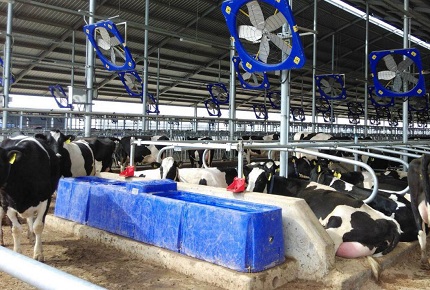Create Time: 09 ,23 ,2024
In the summer, rising temperatures and increased rainfall add to the difficulty of dairy farming. High temperatures and humidity can easily cause heat stress in dairy cows, which can lead to decreased functions of multiple systems such as lactation, reproduction, immunity, and digestion, resulting in significant economic losses. It is recommended to manage dairy cow feeding during summer from the following aspects.
Adjust Feed Formula
First, increase the proportion of concentrated feed and reduce the amount of roughage to provide more energy and nutrition. Second, reduce the amount of regular feed and increase high-quality feed such as soybeans and high-quality forage, appropriately increasing the content of protein, minerals, and vitamins in the feed.
Tip: During the high-temperature season, mixing 0.5% baking soda into the diet is beneficial for the digestion and absorption of cellulose, promoting weight gain in beef cattle.
Arrange Feeding Times Reasonably
Try to feed during the relatively cooler times in the early morning (before 9 a.m.) or late evening (after 8 p.m.) to avoid high-temperature periods. Increase the frequency of feeding and supplement night feeding. It is suggested that the night feeding amount should account for over 60% of the daily diet in summer to compensate for the insufficient intake caused by heat-induced anorexia in dairy cows.
Ensure Ventilation in Cowsheds
For semi-closed cowsheds, open doors, windows, and windproof curtains to increase air circulation inside the shed for cooling purposes. In milking parlors where cows are relatively crowded and more affected by heat stress than in cowsheds, try to use natural wind as much as possible. Avoid letting the wind blown from the dairy farm ventilation fan counteract the natural wind direction.
Provide Sufficient and Clean Drinking Water
Water is the source of life and the most crucial nutrient for dairy cows. Key points of care are as follows:
Dairy cows' water intake significantly increases in summer. Ensure that the stainless steel cattle water trough always has fresh, clean, and cool water. The water temperature should not be too high;
The stainless steel cattle water trough should be shaded, as dairy cows do not like to drink water exposed to sunlight;
Water temperature can affect the rectal temperature and breathing rate of dairy cows. On hotter days, placing ice cubes in the water trough can enhance appetite;
Regularly clean, disinfect, and replace the water in the cattle water trough to keep it fresh and cool, allowing dairy cows to drink freely.
Strengthen Disease Prevention and Control and Monitor Dairy Cow Health
Summer is a high incidence season for diseases. Timely vaccination and deworming are essential. Also, monitor daily the feed intake, rumination, and overall condition of dairy cows, and consult a veterinarian if any abnormalities are observed.
 English
English  中文
中文 






